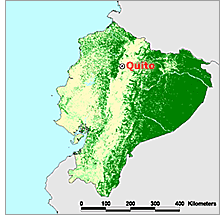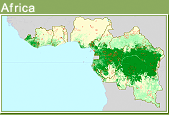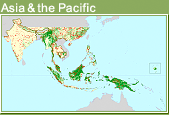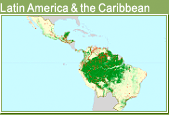Country details
Status of Tropical Forest Management 2005
Latin America & the Caribbean
Ecuador

©UNEP-WCMC 2004
SFM is a long way from being achieved in most of Ecuador's PFE. National forestry institutions remain weak. One reason for this is that there has been no organizational or staffing continuity in the ministry responsible for forests, MAE, and also a lack of clarity in the decentralization process. On the positive side there is a declared political willingness to designate state forests to communes, indigenous communities, settlers and other interested groups if they can prove that they have the capacity to manage and conserve forest resources. Nevertheless, there is little sign of consistent progress towards SFM.
Key points
- Information on the forest sector is quite often poor and contradictory.
- The PFE is estimated to be 7.56 million hectares, of which 3.26 million hectares (including 164,000 hectares of plantations) may be regarded as production PFE.
- At least 101,000 hectares of natural forest in the production PFE are under SFM. Insufficient information was available for an estimate to be made of the extent of protection PFE so managed.
- Native forests are under threat mainly because of the expansion of the agricultural frontier near the coast and in the Amazon area.
- There is strong pressure on the forest from informal and illegal operators resisting change towards SFM, and illegal logging is widespread in all three forest regions.
- Many accessible forests are now degraded and secondary.
- The capacity to implement the national forest program and other forest-related policies and laws is low.
- In many cases, and despite new legislative provisions, forest tenure remains unclear.
- There is a discrepancy between actual harvesting practices and forestry regulations. Harvesting is generally unsustainable, and legal provisions for harvesting operations are unrealistic and may push forest-users towards illegality.
- Institutional weaknesses have created bureaucracy and additional costs, which have been transferred to the private sector. High transaction costs stimulate informality and corruption and increase timber volumes from illegal sources.
- The effective management of protected forests is inhibited by a lack of funding, a lack of sufficient political support to the forest sector and, in some areas, disputes over tenure.

 Africa
Africa  Asia & the Pacific
Asia & the Pacific  Latin America & the Caribbean
Latin America & the Caribbean